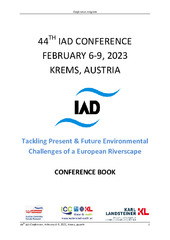Приказ основних података о документу
The Danube's water and biofilms: Antimicrobial resistance in the Enterobacteriaceae populations
| dc.creator | Koller, Michel | |
| dc.creator | Dielacher, Irina | |
| dc.creator | Schachner, Iris | |
| dc.creator | Leopold, Melanie | |
| dc.creator | Jakwerth, Sefan | |
| dc.creator | Kolarević, Stoimir | |
| dc.creator | Kračun-Kolarević, Margareta | |
| dc.creator | Toth, Erika | |
| dc.creator | Savio, Domenico | |
| dc.creator | Farnleitner, Andreas | |
| dc.creator | Kittinger, Clemens | |
| dc.creator | Kirschner, Alexander | |
| dc.creator | Zarfel, Gernot | |
| dc.date.accessioned | 2024-03-15T10:03:13Z | |
| dc.date.available | 2024-03-15T10:03:13Z | |
| dc.date.issued | 2023 | |
| dc.identifier.uri | http://radar.ibiss.bg.ac.rs/handle/123456789/6593 | |
| dc.description.abstract | Human induced antibiotic resistant bacteria (ARB) are not only found in clinical surroundings: large rivers are of great concern as regards their spreading. This ongoing study´s aim is to analyse the major propagation pathways and sources of ARB in the Danube, and to compare the results with data obtained in 2013. Escherichia coli and Klebsiella spp. isolated during the 4th Joint Danube Survey (2019) were tested for their antibiotic susceptibility. 22.24% of 1700 E. coli were resistant and 12.35% were multiresistant. 15.23 % of 696 Klebsiella spp. were resistant and 1.15% were multiresistant. In comparison the data of 2013 and 2019 of both Enterobacteriaceae showed that the wild type is still predominant. There were significant increases especially to fluoroquinolones and augmentin and a significant decrease of resistances to tetracycline. However, the data of JDS4 showed a significant difference between E. coli and Klebsiella spp. regarding wild type, resistance and multiresistance. Additionally, data of 1155 E. coli showed no seasonal trends in Austria during an annual sampling. The comparison of E. coli from biofilms and corresponding water samples revealed several significant differences between the compartments. In conclusion, the preliminary data of E. coli from biofilm samples suggest that the biofilm as a stable colonization within waters reflects especially the long term situation. Thus, the stabilizing and destabilizing effects acting on ARG within the biofilm need to be researched in greater detail. Significant differences between the closely related Enterobacteriaceae species seem to point out the dilemma of E. coli as a solely model organism for environmental long term effects. Klebsiella spp. and their associated ARGs are facing a different selective pressure when encountering the native environmental populations. Finally, the results of the annual sampling campaign suggest that single environmental differences have a higher impact than seasonal events. | sr |
| dc.language.iso | en | sr |
| dc.publisher | Austrian Committee - International Association for Danube Research | sr |
| dc.rights | openAccess | sr |
| dc.source | Conference Book: 44th IAD conference: Tackling Present & Future Environmental Challenges of a European Riverscape; 2023 Feb 6-9; Krems, Austria | sr |
| dc.title | The Danube's water and biofilms: Antimicrobial resistance in the Enterobacteriaceae populations | sr |
| dc.type | conferenceObject | sr |
| dc.rights.license | ARR | sr |
| dc.rights.holder | © 2023 by the Austrian Committee - International Association for Danube Research | sr |
| dc.description.other | Conference Book: 44th IAD conference: Tackling Present & Future Environmental Challenges of a European Riverscape; 2023 Feb 6-9; Krems, Austria. Austrian Committee - International Association for Danube Research; 2023. p. 24. | sr |
| dc.citation.spage | 24 | |
| dc.type.version | publishedVersion | sr |
| dc.identifier.fulltext | https://radar.ibiss.bg.ac.rs/bitstream/id/17060/2023_AbstractBook_44th_IAD_conf_Krems5.pdf | |
| dc.citation.rank | M34 | |
| dc.identifier.rcub | https://hdl.handle.net/21.15107/rcub_ibiss_6593 |

